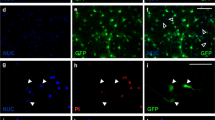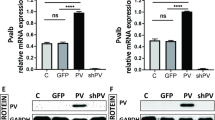Abstract
Cuprizone (CPZ) is a copper-chelating agent and has been shown to induce white matter damage in mice and rats. The compromised white matter and oligodendrocytes (OLs) respond to some antipsychotics in vivo. However, little is known about the effects of antipsychotics on cultured OLs in the presence of CPZ. The aim of this study was to examine effects of some antipsychotics on develo** OLs in the presence of CPZ. Oligodendrocyte progenitor cells (OPCs) were prepared from rat embryos; OLs at different develo** stages were labeled with specific antibodies; levels of CNP and MBP proteins in mature OLs were assessed by Western-blot analysis; malondialdehyde (MDA) levels and activity of catalase were evaluated as well for an assessment of oxidative stress and antioxidative status. In immunofluorescent staining, CPZ was shown to inhibit the differentiation of cultured OPCs into O4-positive cells, reduce the maturation of O4-positive cells into CNP- and MBP-positive cells, and decrease levels of CNP and MBP in mature OLs. These inhibitory effects of CPZ were ameliorated by clozapine and quetiapine (QUE), but not by haloperidol and olanzapine. Further experiments were performed to explore the mechanism of the protective effects of QUE. QUE attenuated the decreases in CNP and MBP in CPZ-treated OLs, and blocked the CPZ-induced increase in MDA and decrease in catalase activity in cultured OLs. These results are relevant to the pathophysiology and treatment of schizophrenia considering the aberrant white matter development and evidence suggesting the derangement of the oxidant and antioxidant defense system in some of the patients with schizophrenia.





Similar content being viewed by others
References
Akyol O, Herken H, Uz E, Fadillioglu E, Unal S, Sogut S, Ozyurt H, Savas HA (2002) The indices of endogenous oxidative and antioxidative processes in plasma from schizophrenia patients. The possible role of oxidant/antioxidant imbalance. Prog Neuropsychopharmacol Biol Psychiatry 26:995–1005
Back SA, Gan X, Li Y, Rosenberg PA, Volpe JJ (1998) Maturation-dependent vulnerability of oligodendrocytes to oxidative stress-induced death caused by glutathione depletion. J Neurosci 18:6241–6253
Baud O, Greene AE, Li J, Wang H, Volpe JJ, Rosenberg PA (2004) Glutathione peroxidase–catalase cooperativity is required for resistance to hydrogen peroxide by mature rat oligodendrocytes. J Neurosci 24:1531–1540
Beers FR Jr, Sizer IW (1952) A spectrophotometric method for measuring the breakdown of hydrogen peroxide by catalase. J Biol Chem 195:133–140
Biancotti JC, Kumar S, de Vellis J (2008) Activation of inflammatory response by a combination of growth factors in cuprizone-induced demyelinated brain leads to myelin repair. Neurochem Res 33:2615–2628
Cammer W (1999) The neurotoxicant, cuprizone, retards the differentiation of oligodendrocytes in vitro. J Neurol Sci 168:116–120
Cammer W, Zhang H (1993) Atypical localization of the oligodendrocytic isoform (PI) glutathione-S-transferase in astrocytes during cuprizone intoxication. J Neurosci Res 36:183–190
Chandran P, Upadhyay J, Markosyan S, Lisowski A, Buck W, Chin CL, Fox G, Luo F, Day M (2012) Magnetic resonance imaging and histological evidence for the blockade of cuprizone-induced demyelination in C57BL/6 mice. Neuroscience 202:446–453
Contreras-Shannon V, Heart DL, Paredes RM, Navaira E, Catano G, Maffi SK, Walss-Bass C (2013) Clozapine-induced mitochondria alterations and inflammation in brain and insulin-responsive cells. PLoS ONE 8:e59012
Davis KL, Stewart DG, Friedman JI, Buchsbaum M, Harvey PD, Hof PR, Buxbaum J, Haroutunian V (2003) White matter changes in schizophrenia: evidence for myelin-related dysfunction. Arch Gen Psychiatry 60:443–456
Dawson MRL, Levine JM, Reynolds R (2000) NG2-expressing cells in the central nervous system: are they oligodendroglial progenitors? J Neurosci Res 61:471–479
Deng W, Wang H, Rosenberg PA, Volpe JJ, Jensen FE (2004) Role of metabotropic glutamate receptors in oligodendrocyte excitotoxicity and oxidative stress. Proc Natl Acad Sci USA 101:7751–7756
Fern R, Möller T (2000) Rapid ischemic cell death in immature oligodendrocytes: a fatal glutamate release feedback loop. J Neurosci 20:34–42
Franco-Pons N, Torrente M, Colomina MT, Vilella E (2007) Behavioral deficits in the cuprizone-induced murine model of demyelination/remyelination. Toxicol Lett 169:205–213
French HM, Reid M, Mamontov P, Simmons RA, Grinspan JB (2009) Oxidative stress disrupts oligodendrocyte maturation. J Neurosci Res 87:3076–3087
Gregg JR, Herring NR, Naydenov AV, Hanlin RP, Konradi C (2009) Downregulation of oligodendrocyte transcripts is associated with impaired prefrontal cortex function in rats. Schizophr Res 113:277–287
Halliwell B (1992) Reactive oxygen species and the central nervous system. J Neurochem 59:1609–1623
Hirahara Y, Matsuda KI, Yamada H, Saitou A, Morisaki S, Takanami K, Boggs JM, Kawata M (2013) G protein-coupled receptor 30 contributes to improved remyelination after cuprizone-induced demyelination. Glia 61:420–431
Hiremath MM, Saito Y, Knapp GW, Ting JP, Suzuki K, Matsushima GK (1998) Microglial/macrophage accumulation during cuprizone-induced demyelination in C57BL/6 mice. J Neuroimmunol 92:38–49
Kimoto S, Okuda A, Toritsuka M, Yamauchi T, Makinodan M, Okuda H, Tatsumi K, Nakamura Y, Wanaka A, Kishimoto T (2011) Olanzapine stimulates proliferation but inhibits differentiation in rat oligodendrocyte precursor cell cultures. Prog Neuropsychopharmacol Biol Psychiatry 35:1950–1956
Koch K, Wagner G, Dahnke R, Schachtzabel C, Schultz C, Roebel M, Güllmar D, Reichenbach JR, Sauer H, Schlösser RG (2010) Disrupted white matter integrity of corticopontine-cerebellar circuitry in schizophrenia. Eur Arch Psychiatry Clin Neurosci 260:419–426
Liebetanz D, Merkler D (2006) Effects of commissural de- and remyelination on motor skill behavior in the cuprizone mouse model of multiple sclerosis. Exp Neurol 202:217–224
Ludwin SK (1978) Central nervous system demyelination and remyelination in the mouse. An ultrastructural study of cuprizone toxicity. Lab Invest 39:597–612
MacAllister SL, Maruf AA, Wan L, Chung E, O’Brien P (2013) Modeling xenobiotic susceptibility to hepatotoxicity using an in vitro oxidative stress inflammation model. Can J Physiol Pharmacol 91:236–240
Makinodan M, Yamauchi T, Tatsumi K, Okuda H, Takeda T, Kiuchi K, Sadamatsu M, Wanaka A, Kishimoto T (2009) Demyelination in the juvenile period, but not in adulthood, leads to long-lasting cognitive impairment and deficient social interaction in mice. Prog Neuropsychopharmacol Biol Psychiatry 33:978–985
Matsushima GK, Morell P (2001) The neurotoxicant, cuprizone, as a model to study demyelination and remyelination in the central nervous system. Brain Pathol 11:107–116
McCarthy KD, de Vellis J (1980) Preparation of separate astroglial and oligodendroglial cell cultures from rat cerebral tissue. J Cell Biol 85:890–902
Messori L, Casini A, Gabbiani C, Sorace L, Muniz-Miranda M, Zatta P (2007) Unraveling the chemical nature of copper cuprizone. Dalton Trans 21:2112–2114
Niu J, Mei F, Li N, Wang H, Li X, Kong J, **ao L (2010) Haloperidol promotes proliferation but inhibits differentiation in rat oligodendrocyte progenitor cell cultures. Biochem Cell Biol 88:611–620
Ohkawa H, Ohishi N, Yagi K (1979) Assay for lipid peroxides in animal tissues by thiobarbituric acid reaction. Anal Biochem 95:351–358
Pasquini LA, Calatayud CA, Bertone Uña AL, Millet V, Pasquini JM, Soto EF (2007) The neurotoxic effect of cuprizone on oligodendrocytes depends on the presence of pro-inflammatory cytokines secreted by microglia. Neurochem Res 32:279–292
Petronilli V, Zoratti M (1990) A characterization of cuprizone induced giant mouse liver mitochondria. J Bioenerg Biomembr 22:663–677
Russanov EM, Ljutakova SG (1980) Effect of cuprizone on copper exchange and superoxide dismutase activity in rat liver. Gen Pharmacol 11:535–538
Silvestroff L, Bartucci S, Pasquini J, Franco P (2012) Cuprizone-induced demyelination in the rat cerebral cortex and thyroid hormone effects on cortical remyelination. Exp Neurol 235:357–367
Venturini G (1973) Enzymic activities and sodium, potassium and copper concentrations in mouse brain and liver after cuprizone treatment in vivo. J Neurochem 21:1147–1151
Virit O, Altindag A, Yumru M, Dalkilic A, Savas HA, Selek S, Erel O, Herken H (2009) A defect in the antioxidant defense system in schizophrenia. Neuropsychobiology 60:87–93
Walterfang M, Velakoulis D, Whitford TJ, Pantelis C (2011) Understanding aberrant white matter development in schizophrenia: an avenue for therapy? Expert Rev Neurother 11:971–987
Wang H, Xu H, Dyck L, Li XM (2005) Atypical antipsychotics protect PC12 cells against amyloid-induced apoptosis by inhibiting oxidative stress. J Neurosci Res 81:572–580
**ao L, Xu H, Zhang Y, Wei Z, He J, Jiang W, Li X, Dyck LE, Devon RM, Deng Y, Li XM (2008) Quetiapine facilitates oligodendrocyte development and prevents mice from myelin breakdown and behavioral changes. Mol Psychiatry 13:697–708
Xu H, Li XM (2011) White matter abnormalities and animal models examining a putative role of altered white matter in schizophrenia. Schizophr Res Treatment. doi:10.1155/2011/826976
Xu H, Wang H, Zhuang L, Yan B, Yu Y, Wei Z, Zhang Y, Dyck LE, Richardson SJ, He J, Li X, Kong J, Li XM (2008) Demonstration of an anti-oxidative stress mechanism of quetiapine: implications for the treatment of Alzheimer’s disease. FEBS J 275:3718–3728
Xu H, Yang HJ, McConomy B, Browning R, Li XM (2010) Behavioral and neurobiological changes in C57BL/6 mouse exposed to cuprizone: effects of antipsychotics. Front Behav Neurosci. doi:10.3389/fnbeh.2010.00008
Xu H, Yang HJ, Rose GM, Li XM (2011) Recovery of behavioral changes and compromised white matter in C57BL/6 mice exposed to cuprizone: effects of antipsychotic drugs. Front Behav Neurosci. doi:10.3389/fnbeh.2011.00031
Xu H, Yang HJ, Zhang Y, Clough R, Browning R, Li XM (2009) Behavioral and neurobiological changes in C57BL/6 mice exposed to cuprizone. Behav Neurosci 123:418–429
Yao JK, Keshavan MS (2011) Antioxidants, redox signaling, and pathophysiology in schizophrenia: an integrative view. Antioxid Redox Signal 15:2011–2035
Yao JK, Reddy R (2011) Oxidative stress in schizophrenia: pathogenetic and therapeutic implications. Antioxid Redox Signal 15:1999–2002
Zhang XY, da Chen C, **u MH, Tang W, Zhang F, Liu L, Chen Y, Liu J, Yao JK, Kosten TA, Kosten TR (2012) Plasma total antioxidant status and cognitive impairments in schizophrenia. Schizophr Res 139:66–72
Zhang Y, Xu H, Jiang W, **ao L, Yan B, He J, Wang Y, Bi X, Li X, Kong J, Li XM (2008) Quetiapine alleviates the cuprizone-induced white matter pathology in the brain of C57BL/6 mouse. Schizophr Res 106:182–191
Zhang Y, Zhang H, Wang L, Jiang W, Xu H, **ao L, Bi X, Wang J, Zhu S, Zhang R, He J, Tan Q, Zhang D, Kong J, Li XM (2012) Quetiapine enhances oligodendrocyte regeneration and myelin repair after cuprizone-induced demyelination. Schizophr Res 138:8–17
Acknowledgments
This work was supported by grants from Southern Illinois University Carbondale (Haiyun Xu) and the University of Manitoba (Haiyun Xu and **n-Min Li).
Conflict of interest
The authors declare no conflict of interest.
Author information
Authors and Affiliations
Corresponding author
Rights and permissions
About this article
Cite this article
Xu, H., Yang, HJ. & Li, XM. Differential effects of antipsychotics on the development of rat oligodendrocyte precursor cells exposed to cuprizone. Eur Arch Psychiatry Clin Neurosci 264, 121–129 (2014). https://doi.org/10.1007/s00406-013-0414-3
Received:
Accepted:
Published:
Issue Date:
DOI: https://doi.org/10.1007/s00406-013-0414-3




